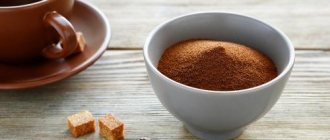Maragogyp coffee: what is this variety and its history?
Maragogipe is a variety of Arabica that has gained fame due to its large grain size, which is 2.5 to 3 times larger than other varieties . A unique feature of this variety is the loose structure of the grain, resembling a sponge, which absorbs nutrients from the air and soil.
How does maragojipe grow?
The taste of Maragogyp coffee is unique. They combine a peculiar sourness and a soft aftertaste, as well as fruity and floral notes. The finished drink is thick and invigorating. Energizes throughout the day and is ideal for use in the morning.
The variety was first discovered in Brazil near the city of Maragogip by chance. When Brazil was just beginning to turn into a coffee country, it was planted with a large number of trees of different varieties, with the hope that at least something would take root. Moreover, they did it chaotically, without distribution of varieties. Flowering coffee trees attracted insects, which collected pollen and mixed it on different trees. This is how Maragogyp coffee was born.
The variety itself is quite capricious and reacts strongly to changes in temperature and humidity. Because of this, crop failures often occur and its price increases.
Many companies have abandoned the production of the “capricious variety”, so in the near future Maragogyp coffee may be equal to elite varieties and cost accordingly.
Where does maragojipe grow?
Maragogype is currently grown in Brazil and four other countries:
- Nicaragua;
- Guatemala;
- Colombia;
- Mexico.
At the same time, Nicaraguan coffee differs from Mexican, and Guatemalan from Brazilian, although they are the same variety. This is due to the instability of the variety, so to select beans it is recommended to purchase small portions of each and try. Below we will look at the characteristics of Maragogip coffee grown in different countries.
If you are growing Arabica at home and are faced with the fact that the leaves of your coffee tree are drying out, quickly read our previous article.
If you love cortado coffee and want to make it at home, this is the place for you.
Today, many cutlery is used to make coffee, but most often a geyser coffee maker and a Turk. If you cannot choose the right solution for yourself, we recommend reading here:.
Harm
Drinking coffee is associated with a high level of tonic properties. However, there is also a downside to positive influence. Yes, after using it you feel a significant surge of strength, however, after a few hours there is a decline. Coffee uses up the body's own reserves without bringing in energy from outside. Addictive. Under the influence of caffeine, the body's digestive system is in a state of stress and digestion is impaired.
The consumption rate for pregnant women should be reduced as much as possible.
The daily intake of coffee is 2 cups of 200 ml, for pregnant women it should be halved.
Drinking is contraindicated:
- with high blood pressure;
- for glaucoma;
- with renal failure;
- for coronary heart disease and atherosclerosis;
- children;
- in old age.
As mentioned above, the structure of the grains of the Maragodzhip variety is loose and absorbs substances contained in the environment. Therefore, you should be careful when choosing grains to avoid purchasing a product grown in unfavorable conditions.
Maragogipe coffee from Nicaragua
Maragojipe, grown in Nicaragua, has the largest grains in the family. Most likely, the climate of Nicaragua suits the coffee tree best. The taste is also impressive.
A characteristic feature is the wine sourness of the finished coffee, which you quickly get used to. After Nicaraguan coffee, you will buy other varieties to try, but after that you will return to Maragojipe from Nicaragua.
A pleasant addition will be floral and fruity notes with a soft aftertaste. This coffee is pleasant to drink in the morning. It gives a moderate boost of energy and, unlike other varieties, does not cause heart palpitations even if you brew strong coffee.
Taste characteristics
Each type of coffee has a different aroma and taste. Both of these parameters depend, first of all, on the country in which the grains were grown, that is, on its climate. As for the aftertaste, it is influenced by factors such as:
- Method of storing fruits.
- The degree of their roasting.
- Grinding fineness.
- Cooking features.
For example, Nicaraguan coffee has a chocolate aroma, while Colombian coffee has a nutty aroma. The Guatemalan drink has a pronounced bitter taste, while the Mexican drink has an almond flavor.
An important factor determining the taste of coffee is the soil in which the tree grew.
Maragogipe coffee from Colombia
Maragogipe is the main coffee produced in Colombia. It has a pleasant taste of nuts and chocolate. Some coffee gourmets highlight notes of baked milk in it. When brewed, coffee releases a chocolate-vanilla aroma that is irresistible.
A distinctive feature of Colombian coffee is its light sourness and delicate bitter taste. The finished coffee is quite dense and perfect for morning drinking.
To extract all the flavors of maragojipe from Colombia, it is recommended to cook it in a Turkish pot.
Maragogype from Mexico
This is a central American Arabica variety, primarily grown in the south of the country. Coffee plantations are located at an altitude of 1300 - 1500 above sea level and absorb all the aroma of nature. The Mexicans themselves call the variety Liquidambar.
Mexican maragojipe has chocolate and nutty tones, but unlike Colombian, it has a lighter consistency. The finished drink has a slight sourness, which perfectly emphasizes the chocolate shade.
Some gourmets consider maragogype from Mexico to be the best. Most people prefer the Guatemalan variety, explaining this by the latter’s more intense aroma.
Reviews
Many coffee lovers who have tasted the drink leave mostly positive reviews.
Anna, Kostroma: I liked the unobtrusive aftertaste with wine or chocolate-nut notes, a pleasant sourness, which you can get rid of if you buy medium-ground beans.
Igor, Moscow: The variety is unlike other Arabica varieties. It has a fruity and floral aroma, giving you a feeling of vigor and energy.
Lisa, Tver: I liked it in combination with milk, and there was no loss of original properties. The coffee is worth trying, despite the high price.
Brazilian Maragojeep
Comparison of regular Arabica with Brazilian Maragogip beans
Today, Brazil practically does not grow maragojipe, explaining this by the capriciousness of the culture. You can verify this by searching for this variety on the Internet. It’s practically non-existent, but if you find it, be prepared to pay an exorbitant price.
In terms of taste, maragogype from Brazil is very similar to Mexican and Colombian, with the exception of some details. The nutty - chocolate shade is expressed weaker in it, and the traditional sourness is a little stronger. The consistency of the finished drink is average. This coffee can be drunk even in the evening, due to its low caffeine content.
Benefit
Coffee beans are high in nutrients. Regular consumption of this natural drink will protect you from the development of various diseases. For example, the likelihood of diabetes will decrease by 50% in men and by 30% in women if you drink 6 cups of coffee a day. Caffeine reduces the risk of developing Parkinson's disease. This is due to the fact that it inhibits signals in the nerve endings through which information is transmitted that triggers the disease.
The Maragogyp variety has a low caffeine content, for this reason it can be consumed by people prone to increased heart rate.
Grains grown on plantations located on volcanic rocks will fully replenish the body with minerals and vitamins.
Maragojip from Guatemala
Maragogipe coffee beans produced in Guatemala are considered the best. And this is not without reason. In Guatemala, coffee trees are grown on the slopes of volcanic mountains 2000 meters above sea level. The plantations are surrounded by tropical trees that protect the maragojipe from direct sunlight. The roots of coffee trees go deep and are saturated with volcanic minerals and pure water.
Coffee production is the most important sector of the country's economy and contributes the lion's share of the budget to its treasury. Therefore, coffee is treated specially here.
Guatemala's harvest is about 160 thousand tons of coffee per year. Another important feature is that farmers in Guatemala are not pursuing the cultivation of new, high-yielding varieties, but have preserved old trees that have grown there for centuries. As a result, with ideal growing conditions, high-quality coffee trees and techniques honed over centuries, Guatemala produces Maragogipe coffee, which has no analogues in the world.
But everything was not so smooth. In 1902, the Santa Maria volcano awoke, covering more than 300 thousand square kilometers with volcanic ash and rock. The people of Guatemala persevered and to this day grow some of the best coffee.
Maragojipe from Guatemala differs in taste from the above varieties. It has a pungent flavor and bright acidity with a smoky aroma (a consequence of the absorption of volcanic minerals by tree roots). At the same time reveals chocolate, fruit and floral aromas.
For lovers of sweets, we have collected several popular recipes for coffee with marshmallows in one place, we recommend that you familiarize yourself with them.
Coffee has firmly entered our lives, and some people cannot imagine their day without a cup of this wonderful drink. Thanks to such popularity, many begin to look for information about their favorite product, for example, what its expiration date or shelf life is. Answers to such questions can be found here.
Bean storage options
The processing of the grains has a direct impact on the shelf life. Fresh green grains can be stored for a year - they will not change their properties. Roasted grains are less stable, they are able to absorb foreign odors and moisture from the air, so their shelf life in a paper bag is no more than two weeks. Foil packaging will preserve coffee for three months, and in a tightly closed glass or ceramic container the beans can be stored for six months.
Subtleties of cooking
Not only maragogip, but any other type of coffee must be brewed correctly. If you use the wrong method, the taste of the drink will be ruined. Below we will look at the most popular methods of brewing coffee beans and determine whether they are suitable for our “giant” or not.
- French press. One of the most commonly used tools for brewing a “strong drink”. It owes its popularity to its ease of use. It is enough to pour ground grains into it, pour boiling water, lower the piston and pour into cups. For our variety, this tool is not entirely suitable, since boiling water, after pouring, cools down and not all essential oils have time to get into our drink.
Brewing "large Arabica" in a Turk
Turk. Here the picture is a little different. The coffee powder is in water, the temperature of which begins to increase, due to which the essential oils from the beans are released more intensely and transferred to the drink in greater quantities than when using a French press.
- Coffee machine. Allows you to completely “take out” essential oils from the maragogip and transfer them to your cup. The end result will be excellent, thick espresso with chocolate notes.
- Geyser coffee maker. In it, the processes of transferring aromatic particles last longer than in a coffee machine and some of the aromatic substances are lost. This brewing method is not as effective as a coffee machine, but it is ideal for those for whom machine espresso is too concentrated and bitter.
Maragogyp coffee is a unique drink that all coffee lovers should try. Some will like it, some not at all, but there will definitely not be anyone indifferent. If you purchased this type of coffee, stock up on a Turkish coffee pot or coffee machine, as they are capable of brewing this type of coffee better than other devices.











